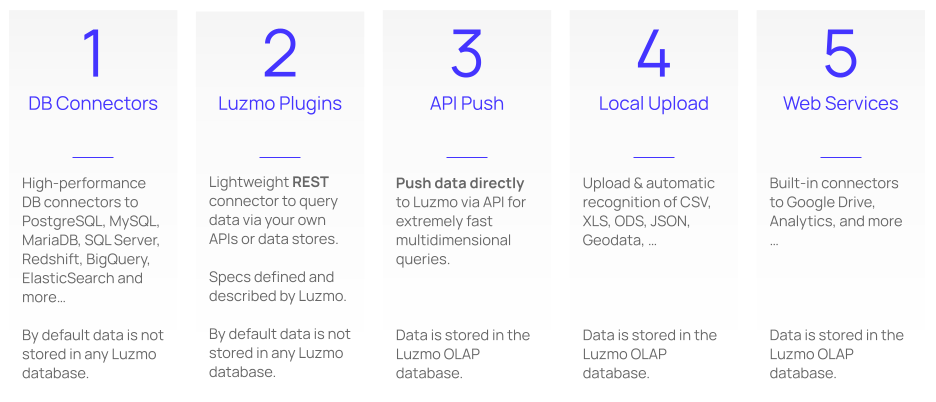How to connect my data?
There are a few ways of connecting your data. In this article we explain the different options and highlight some of the main aspects. Please refer to the respective "Making a XXX Connection" article for your data source for more specific guidelines and information. In case you need to whitelist Luzmo's IP addresses, check out this Academy article for the necessary details.

Direct database connection
Luzmo offers various connectors to integrate with different database systems seamlessly. Simply provide your credentials and potentially whitelist our IP addresses. Explore available standard connectors here.
Data queries are sent directly to your database in real-time when a user accesses a dashboard or dataset. By default, your data remains within your database unless you opt-in for query caching or Warp.
Luzmo Plugin
A Luzmo Plugin acts as a REST API intermediary between Luzmo and your database, API, or web service. Refer to our Plugin API documentation for endpoint details.
Choose from three Plugin options:
- basic plugin: Retrieves all data without aggregation, simplest to set up but least performant.
- basic plugin with filtering: Similar to Basic Plugin but retrieves filtered data, enhancing performance.
- pushdown-enabled plugin: Highest performance option, pushing down both filters and aggregations to retrieve only result data.
Similar to direct database connection, data queries are live and data remains in your system unless you opt-in for query caching or Warp.
API data Push
You can push data directly to Luzmo either incrementally or via scheduled processes. Utilize our data API endpoint to append or replace dataset contents. Refer to our guide on pushing data for more details.
Data pushed to Luzmo is stored in our OLAP database, ensuring the latest dataset status is available upon dashboard refresh.
Local upload
Upload CSV, Excel, GeoJSON, ... files from your local system directly into the Luzmo OLAP database. You have the option to replace or append existing datasets. Learn more about local uploads here.
Like other data sources, Luzmo queries the latest dataset status each time a dashboard is refreshed.
Web Services
You can connect to your Google Drive or Google Analytics account.
After having connected your Google Drive or Google Analytics account, you can now add datasets from it. Once connected, datasets from these sources are synchronized with the Luzmo OLAP database initially. To continue synchronization, set up a sync schedule as per your requirements, detailed here.